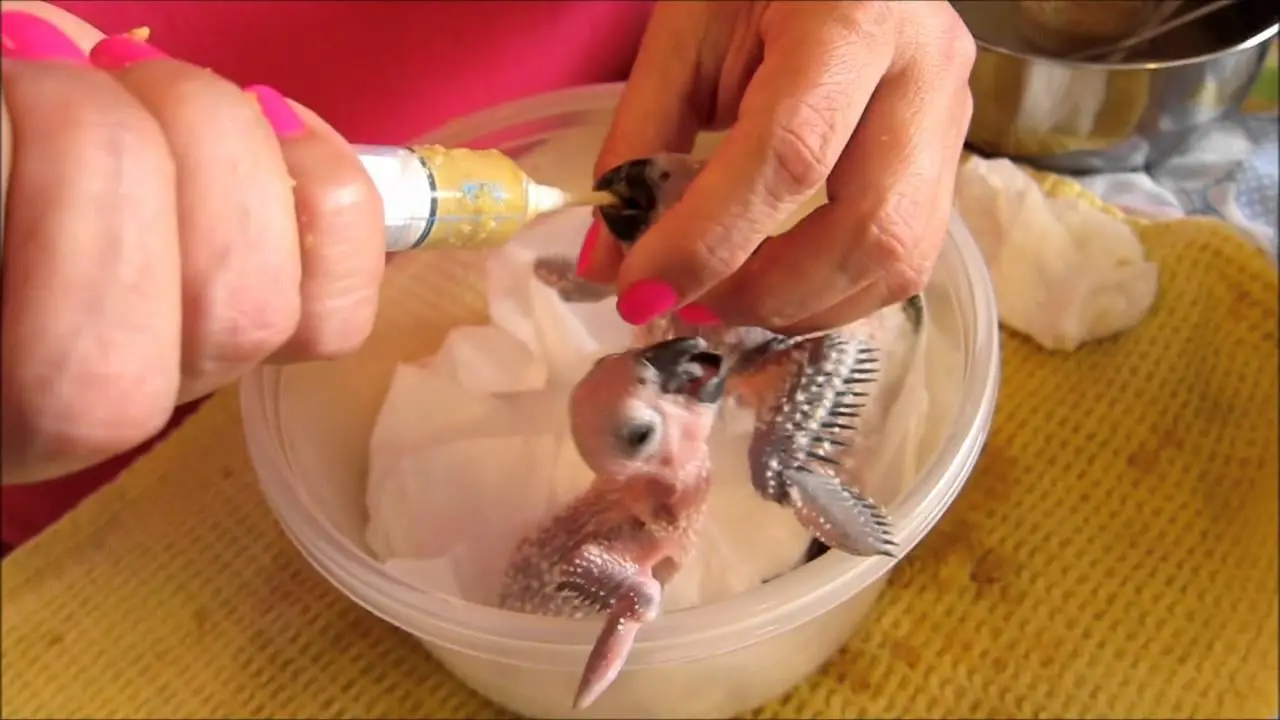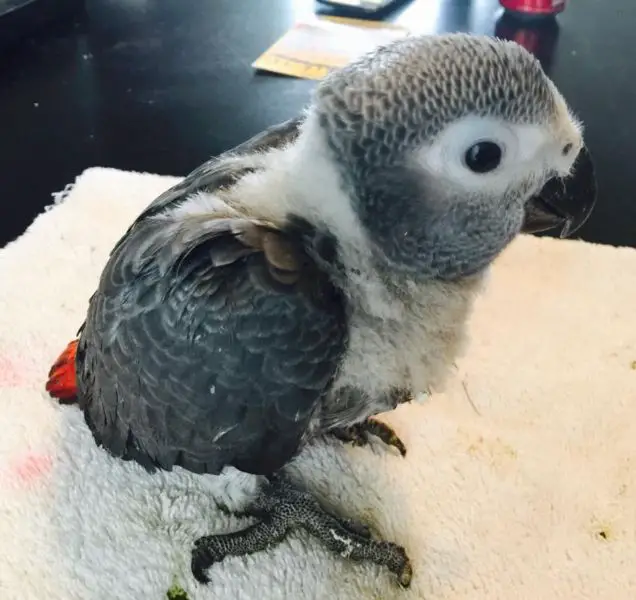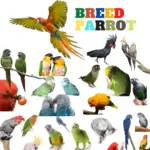
To conclude and summarize the desired goal of this blog, I will try to make sure that “Jaco” can lead you:
-a quiet life away from the many often insidious environmental stresses that reduce the resistance of the immune system and reduce life expectancy, a perfectly balanced life in terms of food.
- A life during which will gradually establish complicity, even a friendship between him and the people of his direct entourage.
- A life with the use of educational techniques through play should become more and more important knowing that it is now proven that “Jaco” can “learn” all his life.
African grey parrot
How to breed a young African grey parrot
There are two subspecies of grey parrots that can be found today in specialized stores and breeders.
Psittacus erithacus Erithacus (the largest) for the grey of the former Congo, the most reproduced and therefore the most widespread today.
Psittacus erithacus Timneh (The smallest) for Timneh.
An untrained eye may have some difficulty in differentiating these two subspecies, but on closer inspection, the anatomical features are sufficiently different not to confuse them.
The beak of a Psittacus erithacus Erithacus in perfect condition. Entirely black.
The beak of a Psittacus erithacus timneh is in perfect condition. Always a “flesh” color task on the upper mandible or rhinotheca.
There is finally a third – – – subspecies of African grey parrot —— much rarer, protected but also strongly discussed. You will not meet her anywhere officially; but at the last news, it may be that it is one and the same subspecies as Psittacus erithacus Erithacus.

Different names of African grey parrot
Congo African Grey Parrot (Psittacus erithacus Erithacus)
The vernacular names most commonly used to identify large Psittacus erithacus Erithacus are: “the African parrot, the grey of Gabon, the congo parrot, the Jaco, the Gabonese and, for the small, namely the Psittacus erithacus Timneh, the two most used names are the “Timneh” of course and the parrot “wine tailed”.
The vast majority of grey parrots currently held in captivity in Benelux, France, and Germany are parrots whose parents or grandparents were from different African countries.
Most of these parrots had left the African continent from Cameroon and the former Belgian Congo (now the Democratic Republic of the Congo), which in the 1970s were two major trading centers. export of parrots.
Supply list
Here’s a list of the necessities you’ll need to
take home to help your new African grey parrot stay
healthy and happy. Please ask one of our pet
experts to help you choose these items.
Housing
cage for African grey parrot
Housing: Purchase the largest cage you can afford, keep in mind that the cage should be wide enough for the bird to stretch out both wings and not touch the sides. Circular cages should be avoided.
Cage placement: Place the cage in an area that is away from the doors of air conditioning vents. A window view would be desirable but make sure your Grey isn’t in direct sunlight.
Toys: Look for strong plastic or wooden toys. Rope toys with wooden blocks are fun but watch for toes getting tangled. African grey parrot can be destructive so don’t be upset if the toys get destroyed and make sure to change out toys often so your Grey doesn’t get bored.
- Cage of appropriate size and bar width
- Paper for cage bottom
- Three or more perches
- Food and water dishes
African grey parrot food
- Appropriate pellet-style food
- Fresh fruits and veggies
- Beak conditioner
- Supplements
African grey parrot adoption
- Birdcare books and literature
- Toys
- Nesting material
- Cage cleaner and disinfectant
(Read and follow label instructions)
African grey parrot breeding
This is the dominant subspecies, larger than the Timneh at about 12″ to 14″long, with light grey feathers, cherry red tails, and an all-black beak.
Immature birds of this subspecies have tails with a darker, duller red towards the tip until their first molt which occurs within 18 months of age.
The African grey congo parrot also initially has grey irises which change to a pale yellow color by the time the bird is a year old.
The Congo grey parrot is found on the islands of Príncipe and Bioko and is distributed from the south-eastern Ivory Coast to Western Kenya, Northwest Tanzania, Southern Democratic Republic of the Congo (DRC), and Northern Angola.

African grey parrot diet
Staple diet: opting for a pellet-style food ought to form the inspiration of the diet, however ought to be supplemented with a range of recent fruits and vegetables, besides grains and proteins. Ask our pet consultants what food most accurately fits your bird’s needs.
Fruits & vegetables: Your bird can get pleasure from 25% of its food within the kind of foliolate inexperienced vegetables like spinach, kale, etc. vegetables such as carrot, celery, inexperienced beans and peas in the pod, fruits such as apple, orange, banana, pomegranate, and pear.
Treats: spray millet or any low quantity of seed mix is fed however they’re for the most part finished and are poorly balanced, therefore they mustn’t type a large part of the diet.
Water: Modify and fill your parrot’s water dish with clean water a day.
African grey parrot behavior
sociableness and intelligence will build African grey Parrot outstanding pets with a strongly devoted following among parrot homeowners.
These same qualities mean that the grey parrot of Gabon demands and demands an exceptional and particular commitment of the owners, who wish a frequent interaction and a supervised day trip in their cage. “.

Talking: African grey parrot square measure thought-about to be the most proficient talking parrot, a name rivaled solely by the Hill mynah bird.
Handling: Parrots will be terribly profitable pets to the right homeowners, because of their intelligence and need to act with individuals. several parrots square measure terribly affectionate, even lovable with trusty individuals, and require plenty of attention from their homeowners.
Some species have an inclination to bond to at least one or 2 people and dislike strangers unless they’re regularly and systematically handled by completely different people. Properly socialized parrots will be friendly, outgoing, and assured companions.
Toys: should be durable enough to resist their strong beak, and massive enough to stay toes from being caught and altered out ofttimes, therefore, your bird will not get bored.
Safety & Cleanliness: Keep your pet’s home clean and wash your hands before and once handling your pet or improving their home.
Infants, young youngsters, pregnant ladies, people with compromised immune systems, and therefore the infirm or older area unit at a bigger risk of infections and should use caution once in-tuned with the pet or its habitat. Consult your doctor for additional info.
African grey parrot health problems
Signs of a healthy African Grey Parrot:
- Clean, bright eyes and nares
- Tightly held feathers
- Inquisitive behavior
- Eats and drinks normally
- Well-formed droppings with no diarrhea
Things to watch for:
- listless
- loose or fluffed up feathers
- sneezing and/or nasal discharge
- heavy or rapid breathing
- sitting on the bottom of the cage
- diarrhea
- feather picking
- sores on feet
- difficulty eating (overgrown beak)
African Grey Parrots | Care and Breeding | Part 1 (Full)
SOURCE: Tyzack TV




















